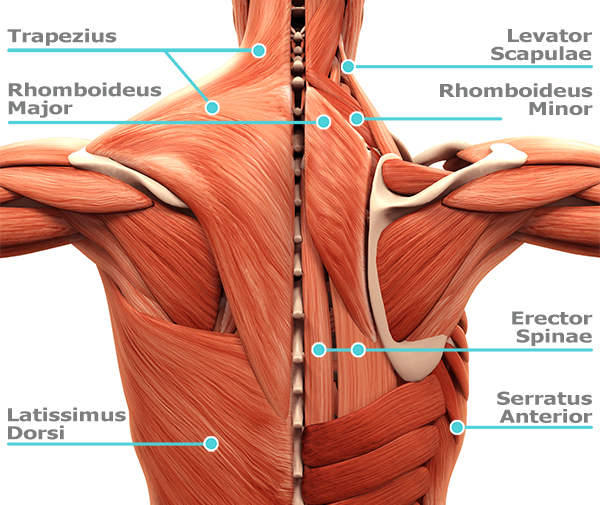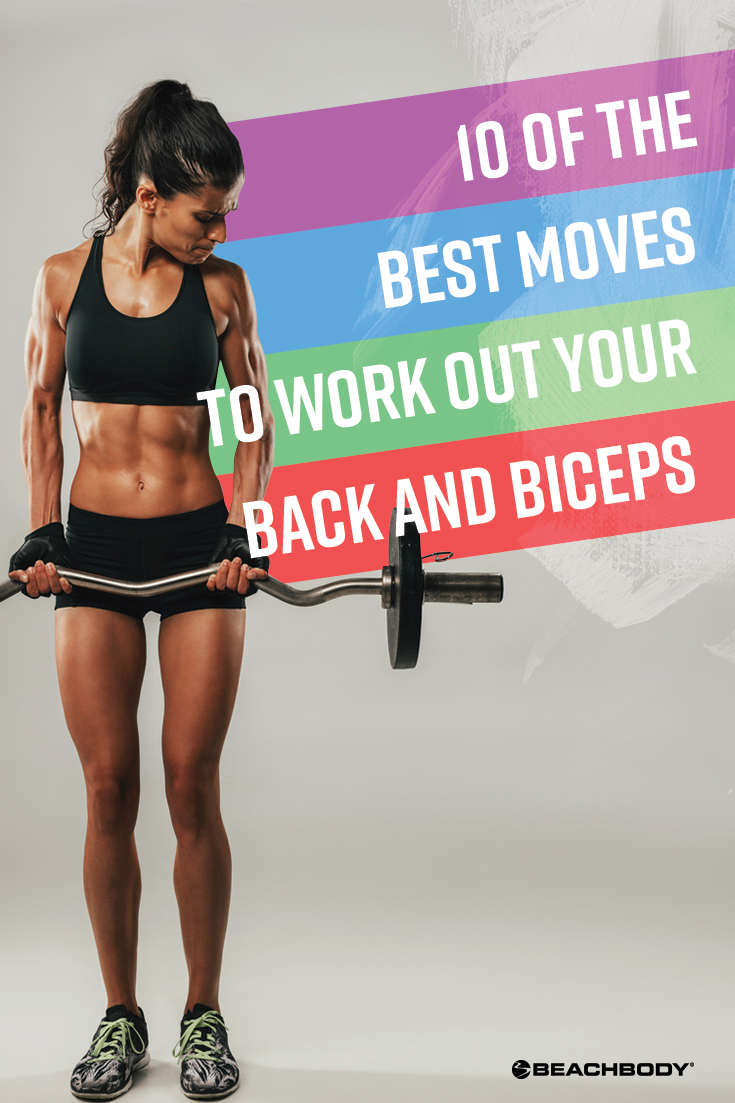10 of the Best Moves to Work Out Your Back and Biceps

While some people might neglect working their back muscles (you can’t even see them!), the biceps are a beloved mirror muscle for many. The locations of these two muscle groups may make them seem totally unrelated, but in fact they’re quite connected.
“Whenever you pull or lift something – whether you’re trying to move an object toward your body or move your body toward an object (as in a pull-up) – you engage your biceps and a handful of your back muscles to make it happen,” says Trevor Thieme, C.S.C.S.
And while you don’t necessarily need to do a specific back and biceps workout each week, you should incorporate back and biceps exercises into your weekly training plan. Strong back and biceps can be a huge help in your daily life.
“The muscles of your back help you stand up straight, reach, pull, and extend your arms, stabilize your shoulders, and stabilize your spine,” Thieme says. As for the biceps, they help you perform everyday movements more efficiently.
“Working your biceps is important because your arms are your primary tools for interacting physically with the outside world,” Thieme says. Lifting a child, pulling open a heavy door, moving furniture, putting bags of groceries in your car — countless daily actions require strong arms and a powerful back.
Add These Back and Biceps Exercises to Your Workout
We went through dozens of programs on BODi to select an assortment of the best back and biceps exercises. You can easily incorporate these movements into your existing routine if you train yourself, but be sure to warm up before every workout.
“Dynamic stretches that mobilize the back, shoulder, and arm muscles – and that move the shoulder joints through their full ranges of motion – are the best ways to prime those muscles for action,” says Thieme.
1. Dumbbell reverse grip row
Appears in: The Master’s Hammer and Chisel – Total Body Chisel
Benefits: This move can help improve posture by challenging the upper and lower back at the same time.
- Stand upright, feet shoulder-width apart and knees slightly bent, holding two medium to heavy dumbbells in front of your body, palms facing forward.
- With your shoulder blades pulled back, hinge forward at the hips until your upper body forms about a 45 degree angle to the floor.
- Keeping your palms turned forward, squeeze your shoulder blades together and bend your elbows, pulling the weights up toward your ribcage.
- Reverse the move and repeat.
2. Lunge twist pull
Appears in: 22 Minute Hard Corps – Resistance 2 (as “Punch Pull”)
Benefits: This move works your lats and upper traps, as well as your lateral and rear delts. The lunge movement also hits muscles in your lower body.
- Stand with your feet wider than shoulder-width apart, holding a medium-weight dumbbell in your right hand at shoulder height.
- Pivot to the left on the balls of your feet, bend both knees into a lunge, and punch toward your left foot on the floor with your right hand.
- As you return to the standing position, place your left hand on the dumbbell and forcefully drive your right elbow backward, pivoting and rotating your torso to the right.
- Repeat on your left side, and do equal reps on both sides.
3. EZ bar row
Appears in: Body Beast – Build: Back/Bis
Benefits: This move works the large muscles of the upper back, while the lower back stabilizes and protects the spine.
- Stand upright, feet shoulder-width apart and knees slightly bent, holding an EZ bar in front of your body with a wide grip, palms facing forward.
- Keeping your lower back in its natural arch and your shoulder blades pulled back, hinge forward at the hips until your upper body forms about a 45 degree angle to the floor, and the bar is near your knees.
- Squeeze your shoulder blades together and bend your elbows, pulling the bar up until it contacts your lower abdomen.
- Reverse the move and repeat.
4. Renegade row
Appears in: SHIFT SHOP – Strength :25
Benefits: This move challenges your upper back and lats while you also work your core and shoulder stabilizers.
- Assume a push-up position with your hands just outside your shoulder-width, gripping two light dumbbells. Your feet should be in line with your hands.
- Lift the dumbbell in your right hand off the floor, bringing your hand to the outside of your ribs while keeping your right elbow close to your side. Resist rotation of the body.
- Lower the right dumbbell to the floor and repeat with your left arm, alternating sides.
6. Alternating row and lunge
Appears in: Autumn’s BOD Exclusives – Kill Cupcake
Benefits: This move works multiple parts of the upper back (lats, traps, and scapular retractors) with light weights, working the muscle fibers responsible for endurance.
- Stand holding two medium to light dumbbells at your sides, palms facing in toward your body.
- Take a big step forward with your left leg, bending it to assume a deep lunge position, keeping your right leg straight.
- Bend forward at your hip, attempting to lay your torso on top of your left thigh. Let your arms hang straight down to the sides of your left leg.
- Bring the dumbbell in your right hand up to the outside of your ribs while keeping your elbow close to your side.
- Reverse the move and repeat with your left arm, alternating sides.
7. In and out biceps curl
Appears in: P90X – Shoulders and Arms
Benefits: This exercise alternately stresses the two heads of each biceps muscle — long and short — with two different grip positions.
- Stand holding a pair of dumbbells with your elbows at your sides and your palms facing forward. This is your starting position.
- Keeping your elbows tucked, curl the weights as close to your shoulders as you can without letting your elbows leave your sides.
- Reverse the movement to return to the starting position.
- Pull your shoulder blades together and rotate your arms so that the backs of your hands face your sides.
- Keeping your arms in this externally-rotated position, curl the weights as close to your shoulders as you can without raising your elbows.
- Reverse the movement to return to the starting position.
- Continue alternating grip positions with each rep.
No dumbbells? Hold the handles of a resistance band and step on the center of the tubing.
8. One arm concentration curl
Appears in: P90X – Back and Biceps
Benefits: This move works the biceps with the upper arm in a vertical orientation, maximizing tension on the muscle in the fully-contracted position.
- Assume a wide, staggered stance with your left leg forward and your left arm supported on your left thigh (as if you were about to attempt to start a lawnmower).
- Holding a dumbbell at arm’s length with your right hand (palm facing forward), make a fist with your left hand and brace the back of your right elbow against the back of your left wrist.
- Keeping your back flat and core braced, curl the weight toward your shoulder.
- Reverse the movement to return to the starting position.
- Do all of your reps, switch sides, and repeat, performing an equal number of reps with each arm.
9. Bicep curl
Appears in: SHIFT SHOP – Strength: 25
Benefits: This classic arm exercise allows you to work the biceps directly using the heaviest weight possible.
- Stand upright holding two dumbbells at arm’s length in front of your thighs, palms facing forward.
- Keeping your back straight and your elbows locked at your sides, slowly curl the weights as close to your shoulders as possible.
- Return to the starting position, and repeat.
10. Hammer curl
Appears in: Body Beast – Bulk arms
Benefits: Switching from an underhand to a neutral grip (so your palm faces inward), increases the load on the brachialis, a muscle lying to the outside of your biceps that adds shape and definition to your upper arm.
- Sit in a chair with your feet flat, your knees spread wide, and a dumbbell in your right hand.
- Bend forward and brace the back of your right elbow against the inside of your right knee. Your right arm should be vertical, with your right palm facing toward you.
- Keeping your upper body still, your elbow against your knee, and your palm facing inward, curl the weight toward your shoulder.
- Pause and then reverse the movement to return to the starting position.
- Do all of your reps, switch sides, and repeat, performing an equal number of reps with each arm.
Back and Biceps Basics
The muscles of the back are divided into three categories. The deep, or “intrinsic,” muscles move the vertebral column and are responsible for controlling posture; the intermediate back muscles control the movements of the rib cage; and the superficial muscles form the outermost layer, playing a vital role in shoulder movement. These superficial muscles, in partnership with the biceps, are what fire up any time you engage in pulling or rowing motions. “Your back muscles pull your upper arm toward your body, and your biceps flex your elbow, bringing your forearm toward your body,” Thieme explains.
Trapezius Anatomy

The trapezius muscles, a.k.a. “the traps,” are two of the superficial back muscles that most people associate with a toned or well-developed back. Any time you shrug, extend your neck, or brace your shoulders to lift or carry a heavy object you’re using your traps.
Shaped like the wings of a stingray, your left and right trapezius muscles extend from the base of your skull to your lower thoracic vertebrae (mid back), and laterally to the clavicles (collar bones) and scapulae (shoulder blades).
Latissimus Dorsi Anatomy
The latissimus dorsi muscles, or “the lats,” are the fan-shaped muscles of the lower back. You’ve likely noticed them on competitive swimmers. that’s because the lats are responsible for arm movements like extension, adduction (bringing the arm toward the body), and medial rotation (turning the front of the arm toward the chest)—basically all of the essential arm movements of swimming. When you consider the thousands upon thousands of hours Michael Phelps’ has spent in the pool, his expansive back suddenly adds up.
Each of the latissimus dorsi muscles has multiple origin points (lower back, sacrum, iliac crest, and lower ribs), and a single insertion point on the back of each humerus.
Biceps Anatomy

While the biceps (or more specifically, the biceps brachii) is not actually attached to the humerus, you’ll find this muscle on the front of the upper arm. It’s comprised of two heads – the short head and the long head – that work to flex the arm at the elbow. The biceps is also responsible for the supination (i.e. outward rotation) of the forearm.
The short and long head originate separately at the scapula and fuse together to attach to the upper forearm.
Tips on Effective Fueling
You can be a dedicated exerciser, but if your diet isn’t on point, it’s unlikely that you’ll see the result you want, whether that’s fat loss, a ripped back, bulging biceps, a more defined physique overall. “The back and biceps are no different from any other muscle in the body when it comes to nutrition,” says Thieme. “Eating a healthful diet with sufficient amounts of protein will facilitate recovery and growth.”
Protein is especially important post-workout. “Studies show that consuming protein–particularly whey protein, like that found in Beachbody Performance Recover–after you work out can help maximize your muscular gains,” says Thieme. In short, feed your body right, and faster results will follow.

